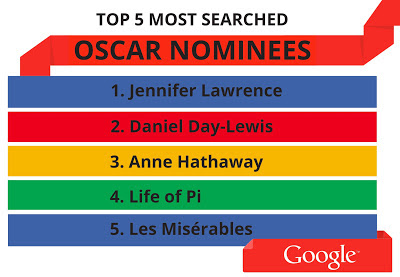The award for “most-searched” nominee goes to...
We took a look at search interest in all of the Oscar nominees across categories. Here's a list of the most searched:

At the end of the show, Best Picture winner “Argo” held the #6 spot, followed by Ang Lee, Christoph Waltz, “Silver Linings Playbook” and Halle Berry.
The 10 most searched red carpet dresses
The red carpet is many people's favorite part of the show. While no Oscar is awarded for "best dress," we wanted to know which gowns caught people's attention this year. The results are in, and the winners are...

Beyond these top five, Brandi Glanville, Amanda Seyfried, Naomi Watts, Kate Hudson and Zoe Saldana took the next top spots.
The moments that caught our attention
This year's Oscars brought with it a number of unexpected moments that grabbed our attention. Early in the show, Seth MacFarlane was visited by William Shatner in full Captain Kirk regalia, come from the future to save Seth’s monologue; at 8:36pm ET, searches for [kirk] spiked to almost 1,500 per minute. Later in the show, “Zero Dark Thirty” and “Skyfall” tied for sound editing, and people flocked to the web with questions. Searches for [tie] spiked to more than 5,000 per minute, with many people wanting to know [has there ever been a tie in the oscars]. And in a final surprise, First Lady Michelle Obama introduced the Best Picture nominees and opened the winning envelope for “Argo.” Searches for [michelle obama] spiked to 4,500 per minute.
For more, check out Google Trends and visit our Oscars site
Before the ceremony started, we shared our “picks”—who would win if the Oscars were determined by search volume alone. Out of the six Google Search Picks, four actually won! Visit Google Trends to explore all the topics you're curious about. And if you want one more tug at the ol’ heartstrings, enjoy a look at the year’s top movies on our Oscars site.







